What is the Best Treatment for Hair Loss?
According to the American Academy of Dermatology, more than 80 million Americans experience hair loss or thinning. While hair shedding, hair thinning, and a receding hairline are common conditions, many patients still find hair loss distressing, leading them to wonder: What is the best treatment for hair loss? The most important first step for developing an effective treatment plan for hair loss is to diagnose the root causes of hair loss. Most commonly, patients may experience hair loss due to genetic conditions, such as androgenetic alopecia (male pattern hair loss and female pattern hair loss) or alopecia areata, stress-related conditions, such as telogen effluvium, malnutrition or anorexia, medications, fungal infection, bacterial infection, hairstyles (traction alopecia), Polycystic Ovary Disease, vitamin deficiencies, Trichotillomania, or hormone imbalance due to puberty, pregnancy, or menopause. Without knowing the root cause of the hair loss that is occurring, it is impossible to prescribe the right medication, supplement, or treatment option, which is why the best first step for hair loss treatment is to schedule a consultation appointment with expert board-certified dermatologist Dr. Michele Green.
Dr. Green offers many treatment options at her New York City dermatology office, depending on the type of hair loss you are experiencing. First, Dr. Green will perform a complete examination of the hair and skin, blood tests, and a scalp biopsy to determine the cause of the hair loss and develop an individualized treatment plan to fit your needs. For some patients, the ideal treatment option may be a topical treatment, such as Rogaine (topical Minoxidil) or Spironolactone. Oral medications, such as finasteride, can be prescribed by a dermatologist in combination with topical treatments. Topical and oral medications can also be combined with in-office treatments, such as platelet-rich plasma injections (PRP) or low-level laser therapy, to strengthen the hair follicles, increase blood flow, and promote new hair growth. Dr. Green can also recommend the best hair products, such as shampoos and conditioners, that will protect from additional hair shedding or hair thinning. To get started on your path to hair care and hair regrowth, schedule your initial consultation with Dr. Michele Green.
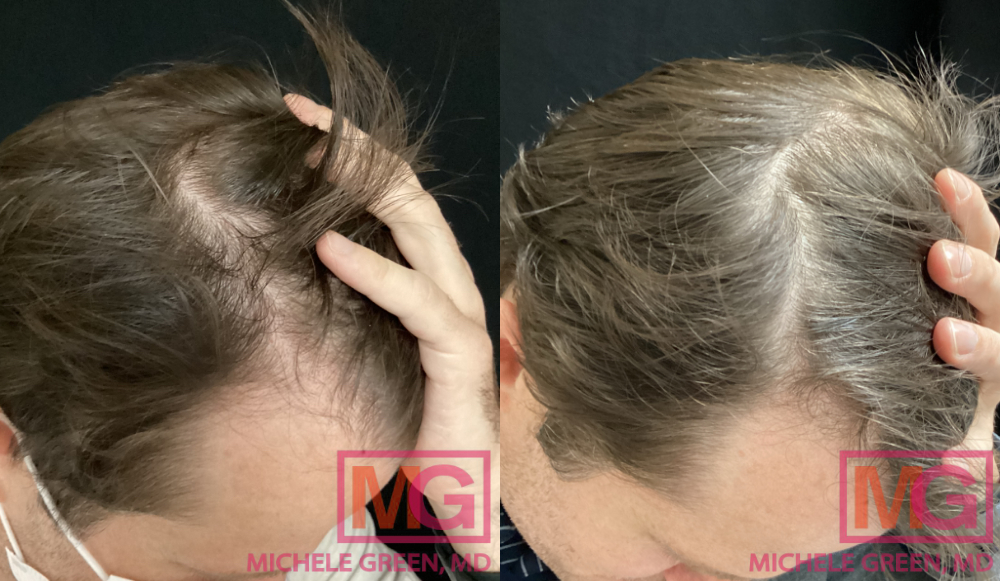
Dr. Michele Green was one of the first dermatologists in NYC to incorporate PRP into her practice and is consistently rated one of the best dermatologists in New York by Castle Connolly, Super Doctors, and New York Magazine for her evaluation, management, and treatment of the different types of alopecia in men and women. Dr. Green treats all types of hair loss, from androgenic alopecia to telogen effluvium to other autoimmune and hormonal causes of hair loss. Based in the Upper East Side of Manhattan, she is an internationally recognized expert for cosmetic and medical hair loss issues. When you consult with Dr. Green in her private dermatology office, you’ll have the opportunity to discuss your medical history, previous cosmetic treatments you may have had, and a thorough investigation of your concerns and cosmetic goals with her in-depth.
What is the cause of hair loss?
The cause of hair loss and hair thinning depends on the type of hair loss present in the patient. A dermatologist diagnoses the type of hair loss first to determine the best treatment options. Typically, Dr. Green will take a multi-pronged diagnostic approach by examining the treatment area, doing blood tests, and discussing any known medical conditions. Some of the most common types of hair loss are as follows:
Androgenic Alopecia
Colloquially known as male pattern baldness or female pattern baldness, androgenetic alopecia is a genetic, hormone-related hair loss disorder. In patients assigned male at birth, androgenic alopecia is characterized by hair thinning along the temples, creating an “M” pattern to the hairline, followed by thinning and a bald spot at the crown of the head. As the condition progresses, patients may lose all of the hair on the crown of the head except for a “U” shape along the sides of the head. Female pattern hair loss is characterized by thinning hair along the top of the head, creating a widening of the part. Androgenetic alopecia occurs when hormonal changes result in high levels of the androgen hormones, called dihydrotestosterone, binding to the hair follicles, leading to a shorter hair growth cycle and thinner strands of hair. While the exact cause of the condition is unknown, researchers believe there is a genetic link, making it a hereditary hair loss condition.
Telogen Effluvium
Telogen effluvium is a stress-related hair loss condition that occurs when patients have undergone significant physical or emotional stress, such as severe illness, infection, high fever, childbirth, major surgery, medications, or a crash diet with insufficient protein intake. Telogen is the name of the resting phase in the hair growth cycle, and when major stress occurs, as many as 70% of all hairs can enter the resting stage. Two to three months later, these hairs all move to the shedding stage at once, resulting in significant hair loss. Unlike androgenic alopecia, telogen effluvium is not a permanent condition. New hair growth typically occurs three to six months after the hair loss event, provided the stress has been resolved.
Alopecia Areata
Alopecia areata is an autoimmune disease in which the patient’s immune system attacks the hair follicles, causing them to shrink and slow new hair growth. The condition is typically characterized by hair loss in patches about the size of a quarter. The amount of hair loss depends on each individual—some lose only a few patches of hair that regrow over time, while others may experience more dramatic and extensive hair loss. Alopecia areata can affect any patient regardless of age and gender and can come on suddenly. While there is no cure for the condition, some patients may find that they have full hair regrowth even without a treatment plan.
Other risk factors can also cause hair loss, including hormonal changes due to pregnancy, certain medications, cancer treatment, thyroid disorders, tight hairstyles such as ponytails, buns, and braids, or friction caused by wigs and hats.
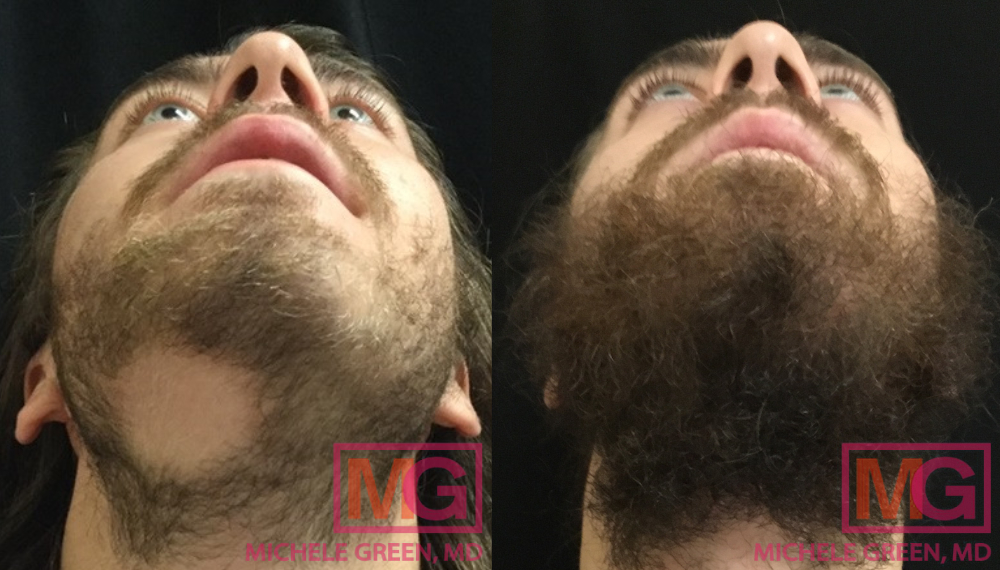
What are the most popular hair loss treatments?
Hair loss and hair thinning are very common conditions affecting as many as 50 million men and 30 million women, and as such, many treatment options are available—some more effective than others. The most effective treatment, however, is the one that works to address your specific cause of hair loss. Depending on the type of hair loss occurring, Dr. Green may recommend prescription medication, such as topical minoxidil (Rogaine), finasteride (Propecia), or spironolactone (Aldactone), an in-office treatment such as PRP injections, low-level laser therapy (LLLT), or lifestyle changes, such as increasing intake of vitamins like biotin and improving your hair care routine for strong, healthy hair.
What is minoxidil (Rogaine) for hair loss and thinning hair?
Minoxidil was originally prescribed to treat high blood pressure but has since been approved by the US Food and Drug Administration (FDA) for hair loss when applied topically or taken orally to help stimulate new hair growth and maintain the health of hair follicles. The only FDA-approved over-the-counter (OTC) medication for hair loss, minoxidil is known as a vasodilator, meaning that when it is applied to the scalp, it widens the blood vessels for increased blood flow to the area. This helps to raise oxygen levels to lengthen the hair growth phase and triggers dormant hairs to grow again. Additionally, minoxidil has anti-inflammatory properties, meaning that it can block androgens, such as DHT, which bind to hair follicles and cause damage. One of the possible side effects of the topical treatment is scalp irritation. Patients experiencing scalp irritation may be prescribed oral minoxidil instead.
What is Finasteride (Propecia) for hair loss?
Finasteride is the generic term for the drug Propecia, which can be used to address male pattern baldness and hair loss. One contributing factor to androgenic alopecia is the binding of dihydrotestosterone (DHT) androgen to hair follicles, which damages the follicle and leads to hair thinning and hair loss. Finasteride is a DHT blocker, meaning that it inhibits the conversion of testosterone into DHT, reducing hair loss. Dr. Green may prescribe finasteride paired with minoxidil for the best results. According to a study published in the Journal of Dermatologic Therapy, 94% of men in the study experienced an improvement in their hair loss condition with minoxidil and finasteride combined.
What is platelet-rich plasma (PRP) treatment for hair loss?
Platelet-rich plasma treatment involves injecting plasma from the patient’s blood into the scalp to prevent hair loss and trigger new hair growth. The procedure begins with a blood draw, which is then placed in a centrifuge to separate the red blood cells from the plasma in the blood. Plasma is a liquid portion of the blood, which can be rich in growth factors that trigger cell regeneration and new tissue growth. The platelet-rich plasma is then injected into the scalp or the receding hairline to extend the growth phase of the hair, improve hair follicle thickness, and increase hair density. As the treatment uses the patient’s own blood, the procedure is free from the risk of allergic reactions or severe side effects. In addition to hair loss treatment, PRP injections can be used for post-surgical healing, osteoarthritis, skin rejuvenation, and musculoskeletal injuries.
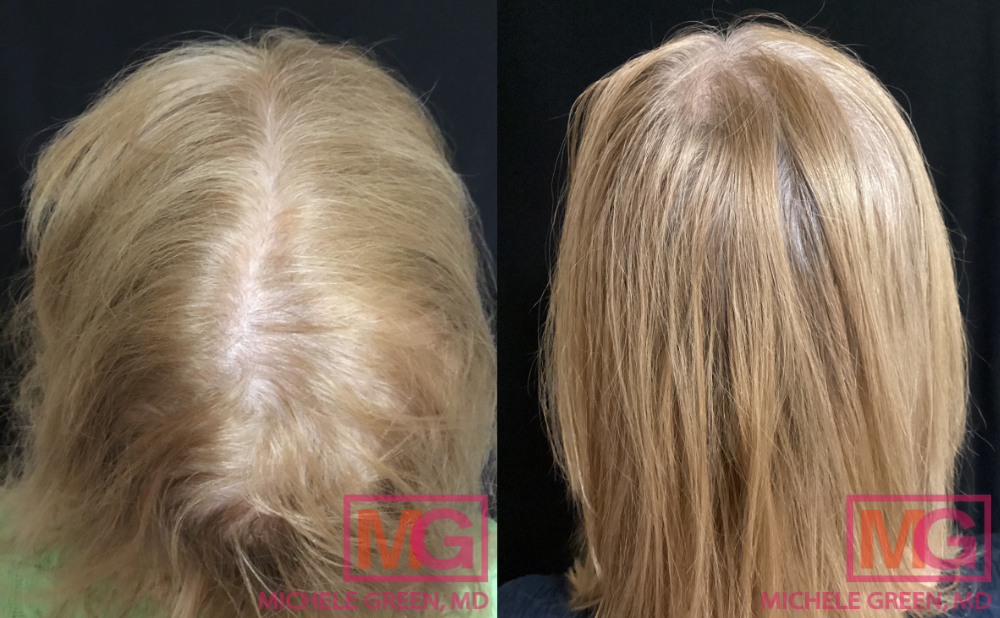
Which hair loss supplement works the best?
One potential risk factor for hair thinning and hair loss is vitamin deficiency—particularly vitamin B, such as biotin. Hair loss supplements are a treatment option to reduce the rate of hair loss and strengthen hair follicles. Viviscal and Nutrafol are two common supplements that are available and have been demonstrated to reduce hair loss in clinical trials. Viviscal is formulated with essential vitamins, such as Biotin, vitamin C, and vitamin B, while Nutrafol contains a vitamin blend for boosting hair growth. The full effectiveness of supplements is still being studied, and the FDA does not regulate supplements as closely as medications. As such, supplements will not provide patients with as dramatic results as a prescription medication or in-office healthcare procedure, such as PRP injections or light therapy.
How do corticosteroids work for hair loss?
Corticosteroids serve various medical functions due to their ability to reduce inflammation and immune system response. Most commonly, corticosteroids are prescribed for many different skin disorders, blood conditions, and arthritis, but corticosteroids can also be used for hair loss conditions. Specifically, corticosteroids work for autoimmune disorders, such as alopecia areata, as the treatment suppresses the body’s immune system, preventing it from damaging the hair follicles. Corticosteroids should only be used under the supervision of a healthcare provider or dermatologist, such as Dr. Green.
What is the best age for a hair transplant?
A hair transplant is a surgical procedure in which hair follicles are moved from an area of the body with active follicles to a balding area—typically the scalp. A hair transplant is an option for patients who have already experienced areas of balding or severe hair follicle damage. Dr. Green recommends that patients wait until they are 30 or older before receiving a hair transplant. Specifically, patients should wait until hair loss has advanced further before receiving the hair transplant, as further hair loss post-surgery may make the scalp look patchy. Dr. Green recommends that patients in the beginning stages of hair loss try non-surgical methods of prevention first.
Does Nutrafol really work for hair loss?
Nutrafol is a supplement that provides patients with essential vitamins to promote new hair growth, treat hormone imbalances, reduce stress, and improve nutrient levels. The FDA does not regulate supplements, but clinical research so far has demonstrated that Nutrafol helps to improve hair growth. Further research is still needed to determine how effective Nutrafol vitamins are compared to other treatment options.
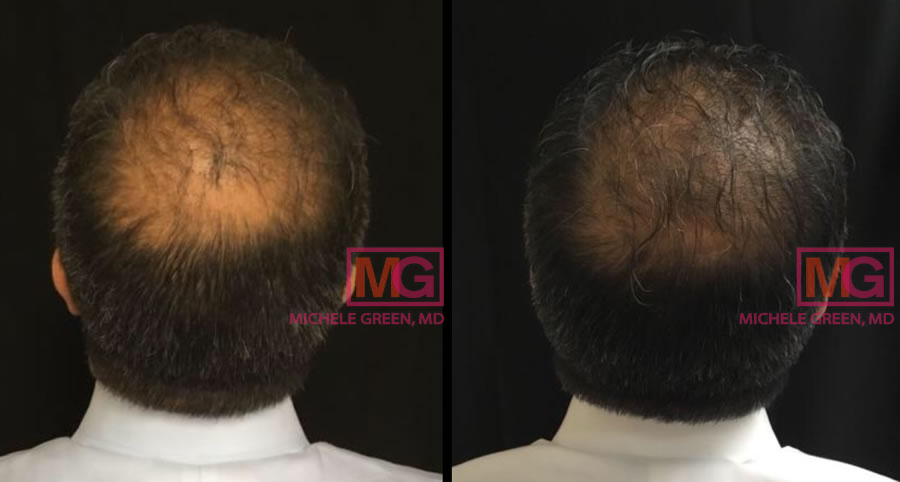
What is the best OTC treatment for hair loss?
The best first step for hair loss treatment is to consult with an expert board-certified dermatologist, such as Dr. Michele Green, who will examine the treatment area and determine the type of hair loss that is occurring. Knowing the cause of the hair loss is essential for choosing the right treatment plan. Many over-the-counter (OTC) medications exist and are advertised constantly, so it can be difficult to know which ones really work. At this time, minoxidil is one of the most popular OTC medications that is FDA-approved to treat hair loss and hair thinning for both men and women.
After your individualized consultation with Dr. Green, she may recommend one of her two unique Hair Revitalizing Serums. These compounded medications are stronger than your generic over-the-counter Rogaine, containing minoxidil 7% and another active ingredient. The Hair Revitalizing Serum for Women also contains progesterone 0.1%, which counteracts the effects of dihydrotestosterone (DHT), a hormone known to contribute to female-pattern hair loss. The Hair Revitalizing Serum for Men contains finasteride 0.1% in addition to the minoxidil 7%. Topical finasteride acts locally, so it does not have the negative side effects of oral finasteride, making the Hair Revitalizing Serum for Men a great alternative treatment for those worried about potential side effects. If you are interested in either of these specialized serums, don’t hesitate to set up an initial consultation with Dr. Michele Green in her NYC office.
How does each hair loss treatment compare?
Dr. Green has many treatment options for hair loss and hair thinning at her New York City dermatology office. The best treatment plan depends on the type of hair loss that the patient is experiencing, as different hair loss treatments work for different types of hair loss. Patients experiencing androgenic alopecia may turn to a combination approach of different hair loss medications, such as topical minoxidil and oral finasteride, which Dr. Green would prescribe. Patients experiencing female-pattern hair loss may be prescribed spironolactone, which is an anti-androgen medication that helps with hormone regulation. In-office treatments, such as PRP injections and LLLT, can also be effective for all patients experiencing this type of hair loss. For telogen effluvium, Dr. Green will often turn to PRP injections, which can help to promote new hair growth. Patients experiencing telogen effluvium will often see regrowth within three to six months, and any treatment is meant to help with the regrowth process. Treating hair loss due to an autoimmune disorder, such as alopecia areata, is more difficult, though corticosteroid injections may help to suppress inflammation and the immune system response.
What are the most effective ways to prevent hair loss?
According to the American Academy of Dermatology (AAD), there are several best practices when it comes to preventing hair thinning and hair loss. One way is to avoid crash diets that severely restrict your protein or calorie intake. Severe dieting can cause stress to the body, resulting in the hair loss condition known as telogen effluvium, where hair follicles stop growth and move into the resting phase early. Additionally, patients should be aware of hairstyles or accessories that create friction or pulling, which can damage the hair follicles over time. As much as possible, patients should wear their hair loose rather than pulled back in a tight bun, ponytail, or braids. Patients can prevent tangling that leads to breakages by using a wide-toothed comb and sleeping on silk or satin pillowcases. Patients can also strengthen their hair by taking vitamins and supplements, such as Nutrafol or Viviscal.
What is the drug of choice for hair loss?
The drug of choice for hair loss depends on the patient’s underlying condition. While minoxidil, finasteride, and spironolactone are three of the most commonly used medications, they are not necessarily for everyone. Minoxidil is best for patients experiencing androgenic alopecia and can be used for patients of all sexes to address both male and female pattern baldness. Finasteride is only approved to address male pattern baldness in men and those assigned male at birth. Spironolactone, on the other hand, is best for female patients experiencing female pattern hair loss and those experiencing hair loss related to the condition called PCOS. When you have your initial consultation with Dr. Green, she will examine the treatment area to determine the underlying cause of hair loss and generate a treatment plan that will work best for you.
What is the newest treatment for hair loss?
With many treatment options to choose from and new treatments constantly being developed, it can be difficult to know what will work best for hair loss. That is why it is always essential to consult with an expert board-certified dermatologist, such as Dr. Michele Green. The newest option is not necessarily the treatment that is most effective for you, and even if it is advertised or shown on social media, it may not be clinically proven to be effective.
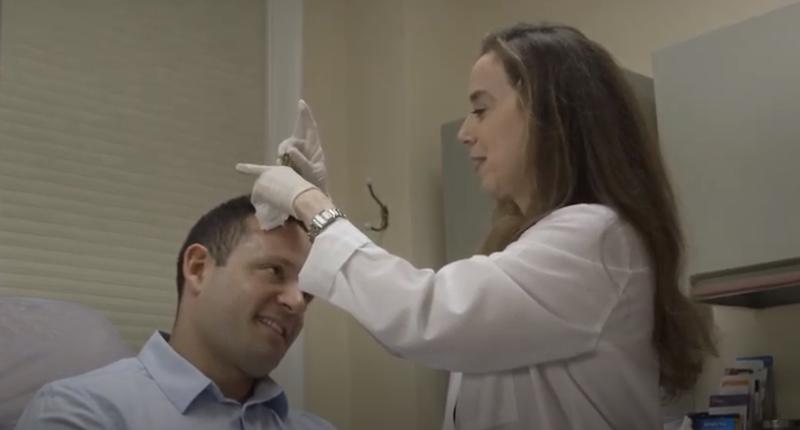
What is the No 1 treatment for hair loss?
The number one treatment for hair loss is the treatment plan generated for you by an expert dermatologist like Dr. Michele Green. Each type of hair loss requires different treatment strategies, and knowing the underlying cause of hair loss is essential to providing the most effective treatment. At Dr. Green’s office, there is a wide range of treatment options, ranging from medications like minoxidil, finasteride, and spironolactone to in-office treatments like PRP injections, LLLT, and more.
How do I get started with hair loss treatment today?
Hair loss can be stressful and debilitating for men and women alike. The best way to prevent and treat hair loss is to live a healthy lifestyle and to intervene at the earliest indication of hair thinning or hair loss. Eliminating stress, proper nutrition, relaxation, sleep, and hair vitamins all play a part in growing and keeping healthy hair. It is important to avoid hair processing or hairstyles that exacerbate hair loss. Suppose you notice hair thinning or excess shedding. In that case, it is important to consult a board-certified cosmetic dermatologist, like Dr. Michele Green in New York City, as quickly as possible to prevent hair loss from progressing. During your initial consultation, Dr. Green will examine the treatment area to determine the underlying cause of hair loss and generate the best treatment plan for you.
Dr. Michele Green is an internationally renowned board-certified dermatologist with over two and a half decades of experience providing her patients with the best non-invasive treatment options. Dr. Green takes a holistic approach and embraces a less-is-more philosophy, creating customized skincare routines and treatment plans that cater to the unique concerns and aesthetic goals of her patients. She is consistently identified as one of New York’s best dermatologists by Castle Connolly, New York Magazine, and Super Doctors for her dedication to her patients and expertise. Please call us at 212-535-3088 or email our New York City-based office today to schedule a consultation with Dr. Michele Green and treat your hair loss.
 212-535-3088
212-535-3088